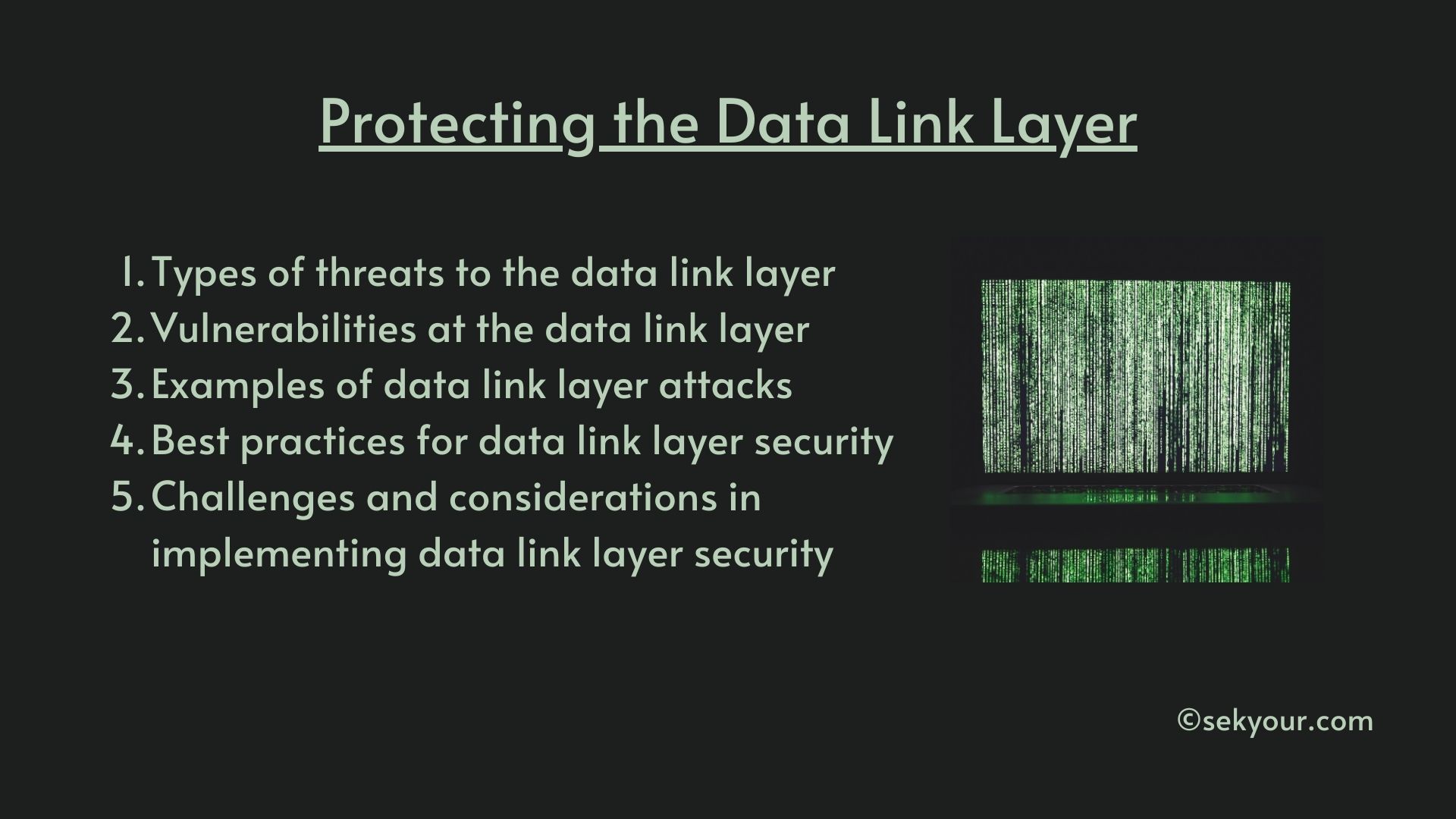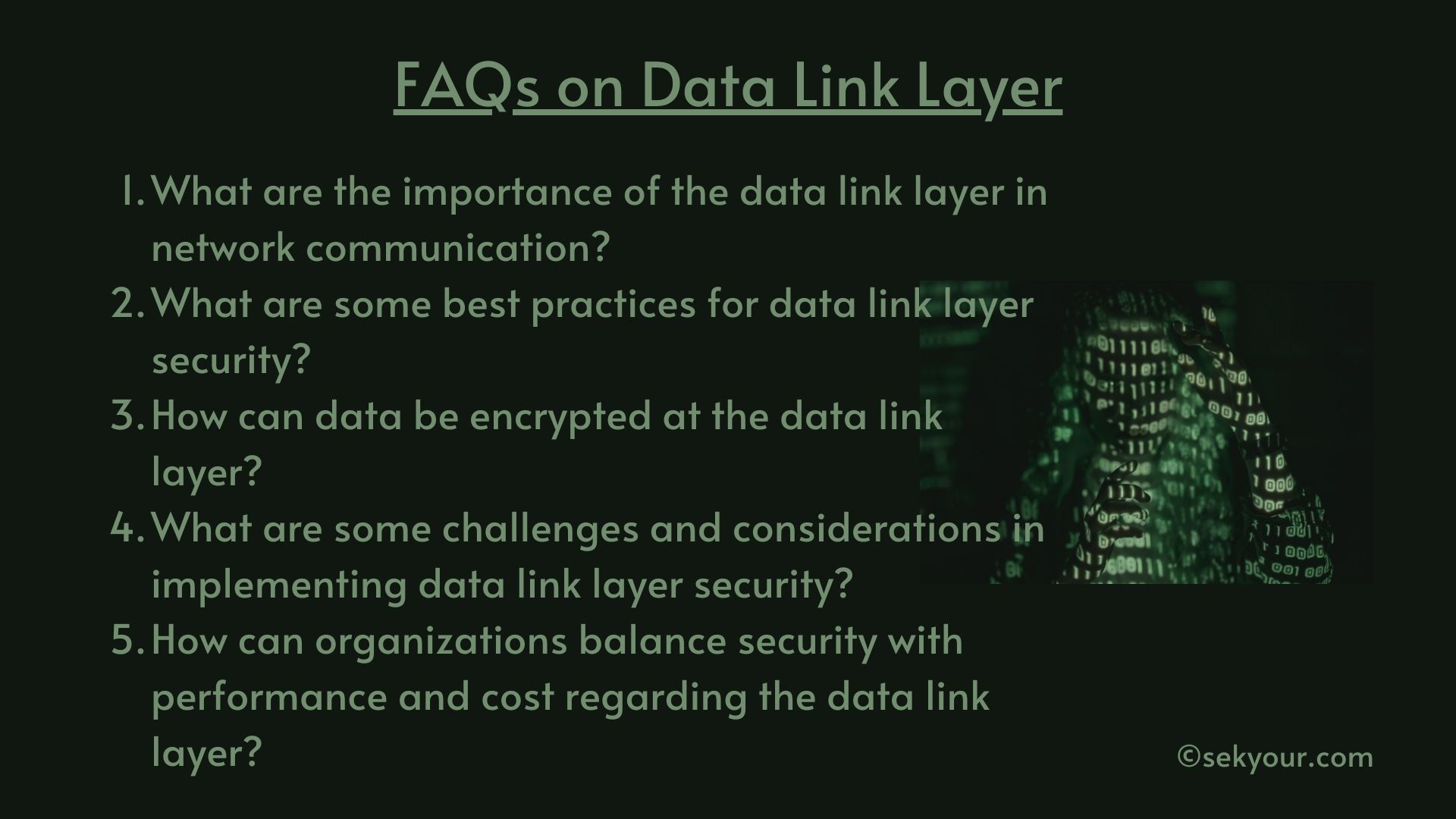1. Introduction to data link layer security
The data connection layer is the second layer of the OSI model, which is used to comprehend how different networking protocols communicate. It is responsible for error detection and correction, flow management, and data packet framing to establish a dependable connection between devices on a local area network (LAN).
Cybercrime has contributed to a loss of $6 trillion annually by 2021, with a significant portion of attacks targeting the data connection layer, according to research by Cybersecurity Ventures. These figures demonstrate the significance of protecting the data link layer and the possible repercussions of failing to do so.

2. Types of threats to the data link layer
Man-in-the-middle (MITM) attacks include an attacker secretly intercepting and changing communication between two parties. If a hacker can enter a network and influence device communication, this kind of assault may take place at the data link layer. An attacker might, for instance, intercept and modify communications sent between a client and a server, giving them access to confidential data or stealing login information.
Attacks known as denial of service (DoS) are attempts to stop legitimate users from accessing a network by flooding it with traffic. If a hacker can saturate a network with traffic and stop devices from communicating with one another, this kind of assault can take place at the data link layer. Botnets, networks of compromised machines that may be used to execute coordinated attacks, can be used to carry out DoS attacks.
A hacker intercepts and keeps track of communication between devices on a network while sniffing and eavesdropping. If an attacker can access a network and utilize specialised software to capture and analyse data packets, this attack may occur at the data link layer. Sniffing and eavesdropping can be used to obtain private data, including login credentials or financial information.
Accessing and modifying network equipment directly is known as physical tampering. If a hacker can gain physical access to network equipment, such as a router or switch, and change its configuration or firmware, this kind of assault may take place at the data link layer. Physical interference can provide an attacker access to a network without authorization or stop devices from communicating with one another.
3. Vulnerabilities at the data link layer
Security protocol problems might result in vulnerabilities at the data link layer. If a security protocol contains known weaknesses, an attacker may be able to acquire network access or steal sensitive information. Maintaining current security protocols and utilizing secure versions is essential to avoid this danger.
Unsecured or improperly configured network devices can constitute a data connection layer flaw. If a network device has a weak or default password or is not configured securely, an attacker may be able to access it and the network to which it is attached. It is crucial for data connection layer security to ensure that network devices are configured securely and protected by robust passwords.
Inadequate access restrictions and authentication techniques may constitute a data connection layer flaw. If access restrictions are not configured or ineffective authentication techniques are employed, an attacker may obtain unauthorized access to a network or sensitive information. Robust access controls and authentication measures, such as two-factor authentication, help mitigate this risk.
Cybersecurity Ventures predicts that there will be 3.5 million unfilled cybersecurity positions by 2021, indicating a severe shortage of experienced cybersecurity workers. This deficiency can contribute to vulnerabilities at the data link layer as a result of the inability of some organizations to adequately safeguard their networks. Moreover, according to research by the Ponemon Institute, the average time to identify a data breach is 197 days, highlighting the significance of having robust security measures to avoid attacks.
4. Examples of data link layer attacks
WiFi spoofing is a type of data link layer attack in which an attacker creates a bogus WiFi access point with a name similar to a legitimate one to trick users into connecting. An attacker may monitor and manipulate a user’s communications once they relate to the bogus access point. WiFi spoofing can steal sensitive data, such as login credentials and financial data.
ARP poisoning is a type of data link layer attack in which an attacker modifies a device’s Address Resolution Protocol (ARP) database to redirect traffic intended for another device to their own. This type of attack can be used to conduct man-in-the-middle attacks or to disrupt device communication.
Ethernet spoofing is a data link layer attack in which an attacker creates a bogus Ethernet connection to trick devices into connecting to it. Once a device connects to a fake connection, the attacker may be able to monitor and manipulate the device’s communications. Ethernet spoofing can be used to steal sensitive data or to disrupt device communication.
A real-world data link layer attack is the “Krack” vulnerability, which compromised the WiFi Protected Access II (WPA2) security protocol. An attacker could exploit the flaw to conduct man-in-the-middle attacks and decrypt sensitive data transferred over WiFi. Another case in point is the “Ethernet spoofing” attack, in which attackers stole login credentials from hotel guests by using a bogus Ethernet connection. These examples highlight the importance of implementing robust security mechanisms at the data link layer to prevent these types of attacks.
5. Best practices for data link layer security
Encrypting data at the data link layer is a best practise for securing network communication. Encryption converts data into a secure, encrypted format that can be accessed only with a decryption key. It is more difficult for an attacker to intercept and read sensitive information transmitted over the network when data is encrypted at the data link layer.
Implementing secure protocols such as WPA2 or TLS is also recommended for data link layer security. Protocols are sets of rules that govern network communication between devices. By encrypting communication and authenticating the identity of devices, secure protocols can help to prevent attacks such as man-in-the-middle attacks.
Updating software and security protocols regularly are essential to data link layer security. As new vulnerabilities and threats emerge, it is critical to keep software and security protocols up to date to protect against them.
Ensuring secure network device configuration is another critical best practice for data link layer security. This entails configuring devices, such as routers and switches, with strong passwords and security settings and regularly updating the firmware to keep it up-to-date and safe. Proper network device configuration can prevent unauthorised access and tampering.
6. Challenges and considerations in implementing data link layer security
Balancing security with performance and cost is a challenge when it comes to implementing data link layer security. Increasing security measures can frequently degrade performance because more secure protocols and technologies may necessitate more processing power and bandwidth. To ensure that the data link layer is secure without negatively impacting the user experience or the budget, it is critical to strike a balance between security and performance, as well as cost.
Managing the complexity of securing an extensive, distributed network is also a challenge when it comes to data link layer security. Many different devices and protocols may be used in a large network, making it challenging to implement and maintain consistent security measures. It is critical to have a centralized security strategy in place to ensure the security of all devices and protocols.
Another challenge in data link layer security is ensuring secure communication between devices using different security protocols. It can be challenging to ensure that communication between devices on a network that uses a variety of protocols is secure. It is critical to have a plan in place to ensure communication security between devices using different protocols, such as implementing a protocol translation layer or using a secure VPN.
7. Conclusion and future outlook for data link layer security
Securing the data link layer is critical for a network’s overall security. The data link layer establishes a dependable link between devices on a local area network (LAN). It is essential to ensure confidentiality, integrity, and communication availability between these devices. Man-in-the-middle attacks, denial of service attacks, eavesdropping and sniffing, and physical tampering are all threats to data link layer security.
The use of artificial intelligence (AI) and machine learning (ML) to detect and prevent attacks, the adoption of software-defined networking (SDN) to improve network security and agility, and the use of blockchain for secure communication and data storage are all emerging technologies and trends in data link layer security.
Organizations seeking to improve their data link layer security posture should consider implementing robust security protocols and encryption, regularly updating software and security protocols, and ensuring network device security. Furthermore, it is critical to implement a centralized security strategy and periodically assess and test the data link layer’s security.
8. FAQs on the Data Link Layer

1. What is the importance of the data link layer in network communication?
The data link layer is essential in network communication because it creates a reliable link between devices on a local area network (LAN). It provides error detection and correction, flow control, and framing of data packets, ensuring that data is transmitted accurately and efficiently.
2. What are some best practices for data link layer security?
Some best practices for data link layer security include encrypting data at the data link layer, implementing secure protocols such as WPA2 or TLS, regularly updating software and security protocols, and ensuring the secure configuration of network devices.
3. How can data be encrypted at the data link layer?
Data can be encrypted at the data link layer by using an encryption algorithm to convert the data into a secure, encrypted format that can only be accessed with a decryption key. This helps to protect against eavesdropping and other attacks that aim to intercept sensitive information transmitted over the network.
4. What are some challenges and considerations in implementing data link layer security?
Some challenges and considerations in implementing data link layer security include balancing security with performance and cost, managing the complexity of securing a large, distributed network, and ensuring secure communication between devices using different security protocols.
5. How can organizations balance security with performance and cost regarding the data link layer?
To balance security with performance and cost when it comes to the data link layer, organizations should consider the trade-offs between different security measures and choose those that provide the most protection without negatively impacting performance or costing too much. It is essential to find a balance between security and performance, as well as cost, to ensure that the data link layer is secure without negatively impacting the user experience or the budget.